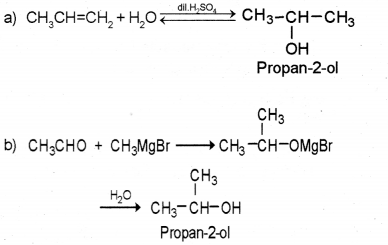Kerala Plus Two Chemistry Model Question Paper 1 with Answers
| Board | SCERT |
| Class | Plus Two |
| Subject | Chemistry |
| Category | Plus Two Previous Year Question Papers |
Time: 2 Hours
Cool off time: 15 Minutes
Maximum: 60 Score
General Instructions to candidates:
- There is a ‘cool off time’ of 15 minutes in addition to the writing time of 2 hrs.
- Use the ‘cool off time’ to get familiar with the questions and to plan your answers.
- Read questions carefully before you answering.
- Read the instructions carefully.
- Calculations, figures, and graphs should be shown in the answer sheet itself.
- Malayalam version of the questions is also provided.
- Give equations wherever necessary.
- Electronic devices except non-programmable calculators are not allowed in the Examination Hall.
Questions from 1 – 7 Carry 1 Score each. Answer all the questions. (7 × 1 = 7)
Question 1.
The edge length and axial angles of a unit cell are a = b = c and α = β = γ = 90° respectively. Identify the type of Crystal System.
Answer:
Cubic
Question 2.
Name the polymer used for non-stick surface coated utensils.
Answer:
Polytetrafluoroethene/Teflon
Question 3.
Which of the following forms coloured compounds
i) Sc3+
ii) Cr2+
iii) Zn2+
iv) Cu+
[Atomic number Sc-21, Cr-24, Zn-30, Cu-29]
Answer:
ii) Cr2+
Question 4.
The rate expression of a reaction is Rate = K [A]1/2 [B]1/2. Calculate its overall order.
Answer:
Overall order = \(\frac{1}{2}+\frac{3}{2}\) = 2
Question 5.
Among the following amines, identify the one that does not reach with Hinsberg reagent.
i) C2H5NH2
ii) (CH3)2NH
iii) (C2H5)2NH
iv) (CH3)3N
Answer:
iv) (CH3)3N
Question 6.
The Carbohydrate, that is known as ‘animal starch’ is …………
Answer:
Glycogen
Question 7.
Name the class of drug used for the treatment of stress and mental diseases.
Answer:
Tranquilizers
Questions from 8 – 20 Carry 2 Score each. Answer any 10 questions. (10 × 2 = 20)
Question 8.
Write the names and structures of the monomers of the polymer Buna-S.
Answer:
1, 3-Butadiene CH2=CH-CH=CH2
Styrene/Vinyl benzene C6H5-CH=CH2
Question 9.
Calculate the packing efficiency in body centred cubic structure.
[Given that r = \(\frac{\sqrt{3}}{4}\)a, where ‘r’ is the radius of sphere and ‘a’ is the edge length of unit cell]
Answer:
In body centred cubic (bcc) structure, total number of atoms per unit cell is 2.
Volume of atoms in the unit cell = 2 × (\(\frac{4}{3}\))πr3
Volume of the cube = a3 = (\(\frac{4}{\sqrt{3}}\)r)3
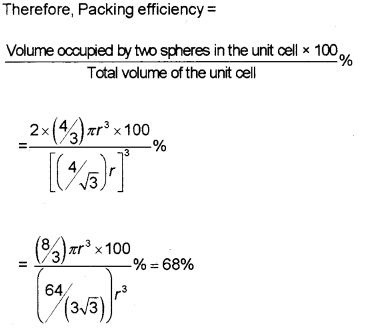
Question 10.
Write one method for the preparation of sulphur dioxide. How is its presence detected?
Answer:
Sulphur dioxide is obtained when sulphur is burnt in air or oxygen.
S(s) + O2(g) → SO2(g)
OR
In the laboratory, it is prepared by treating a sulphite with dilute sulphuric acid.
SO32-(aq) + 2H+(aq) → H2O(l) + SO2(g)
OR
Industrially, it is produced as a by-product of the roasting of sulphide ores.
4FeS2(s) + 11O2(g) → 2Fe2O3(s) + 8SO2(g)
The sulphur dioxide gas decolourises acidified potassium permanganate solution. This is a convenient test for the gas.
5SO2 + 3MnO4– + 2H2O → 5SO42- + 4H+ + 2Mn2+
Question 11.
Write the IUPAC names of following compounds.
a) K3[Fe(CN)6]
b) Co[Cl2(en)2]Cl
Answer:
a) Potassium hexacyanoferrate(III)
b) Dichloridobis(ethane-1, 2-diamine)cobalt(III) chloride
Question 12.
Define van’t Hoff factor ‘i’. What would be the value of ‘i’ for a dilute solution of K2SO4 in water?
Answer:
The van’t Hoff factor, ‘i’ is defined as:
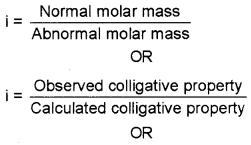
![]()
K2SO4 ionises in water as,
K2SO4 → 2K+ + SO42-
Therefore, for a dilute solution of K2S04 in water the value of i = 2 + 1 = 3
Question 13.
By taking ethyl bromide as starting material, prepare ethyl iodide and ethyl fluoride.
Answer:
Ethyl bromide is treated with Nal in dry acetone to get ethyl iodide. (Finkelstein reaction)
CH3CH2Br + Nal → CH3CH2l + NaBr
Ethyl bromide is heated with metallic fluorides such as AgF, Hg2F2, CoF2 or SbF3 to get ethyl fluoride. (Swarts reaction)
CH3CH2Br + AgF → CH3CH2F + AgBr
Question 14.
Write the complete reaction representing the disproportionation of benzaldehyde.
Answer:
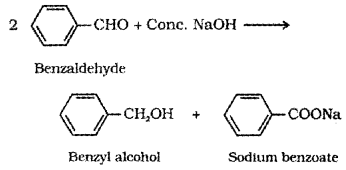
This reaction is called Cannizzaro reaction.
Question 15.
Vapour pressure of water at 293 K is 17.535 mm Hg. Calculate the vapour pressure of water at 293 K when 25g of glucose is dissolved in 450 g of water.
Answer:
\(p_{1}^{0}\) = 17.535 mm Hg, w2 = 25g, M2 = 180g mol-1, w1 = 450 g, M1 = 18 g mol-1, p, = ?

Therefore, vapour pressure of glucose solution,
p1 = \(p_{1}^{0}\) – 0.09742
= 17.535 – 0.09742 = 17.4376 mm Hg
Question 16.
Name the products of hydrolysis of sucrose and explain why sucrose is not a reducing sugar.
Answer:
Sucrose on hydrolysis gives equimolar mixture of D-(+)-glucose and D-(-)-fructose.
![]()
In sucrose, the two monosaccharide units (glucose and fructose) are held together by a glycosidic linkage between C1 of α – glucose and C2 of β – fructose. Since the reducing groups of glucose and fructose are involved in glycosidic bond formation, sucrose is a non-reducing sugar.
Question 17.
Tertiary butyl bromide react with aqueous NaOH to give tertiary butyl alcohol proceeds via SN1 reaction. Write the mechanism of the reaction.
Answer:
![]()
Mechanism: This reaction occurs in two steps:
Step I: The polarised C-Br bond undergoes slow cleavage to produce tert-butyl carbocation and a bromide ion.

Step II: The carbocation is attacked by the nucleophile OH– to form the product, tert-butyl alcohol.

Question 18.
Give the structures of A and B in the following reaction.
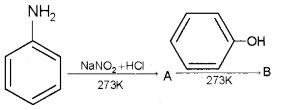
Answer:

Question 19.
Match the following
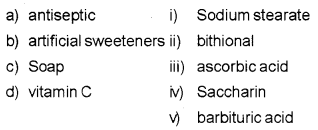
Answer:
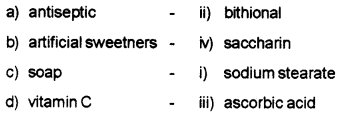
Question 20.
Write a simple chemical test to distinguish ethanal from propanone.
Answer:
Tollens’ Test – On warming with Tollens’ reagent ethanal gives a bright silver mirror while propanone will not give silver mirror.
OR
Fehling’s Test – On heating with Fehling’s reagent ethanal gives a reddish brown precipitate while propanone do not respond to this test.
Questions from 21 – 29 Carry 3 Score each. Answer any 7 questions. (7 × 3 = 21)
Question 21.
The resistance of a 0.5 M solution of an electrolyte enclosed between two platinum electrodes 1.5 cm apart and having an area of 2.0 cm2 was found to be 30Ω. Calculate the molar conductivity of the solution.
Answer:
M = 0.5 M, l = 1.5 cm, A = 2 cm2, R = 30Ω, \(\Lambda_{m}\) = ?
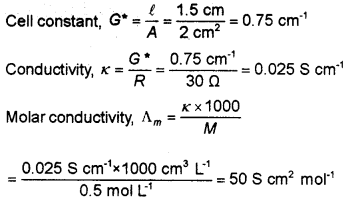
Question 22.
Write notes on different allotropic forms of phosphorous.
Answer:
The important allotropic forms of phosphorus are white, red and black phosphorus.
White phosphorus: white waxy solid, poisonous, insoluble in water but soluble in CS2, glows in dark, dissolves in boiling NaOH solution in an inert atmosphere giving PH3.
P4 + 3NaOH + 3H2O → PH3 + 3NaH2PO2
It readily catches fire in air to give dense white fumes Of P4O10.
P4 + 5O2 → P4O10
It consists of discrete tetrahedral P4 molecules. It is less stable because of angular strain in P4 molecule where the angles are only 60°.

Red phosphorus: obtained by heating white P at 573K in an inert atmosphere for several days. This when heated under high pressure, a series of phases of black P is formed. It possesses iron grey lustre. It is odourless, non-poisonous, insoluble in water as well as in CS2, much less reactive than white P, does not glow in dark. It is polymeric, consisting of chains of P4 tetrahedra linked together as shown:

Black phosphorus: It has two forms, α -Black P and β -Black P.
α -Black P: It is formed when red P is heated in a sealed tube at 803 K, can be sublimed in air, has opaque monoclinic or rhombohedral crystals, does not oxidise in air.
β -Black P: It is prepared by heating white P at 473K under high pressure. It does not burn in air upto 673 K.
Question 23.
Integrated rate equation for a first order reaction.
K = \(\frac{2.303}{t} \log \frac{\left[R_{0}\right]}{[R]}\)
a) Derive an expression for half life of first order reaction.
b) Find the half life of a first order reaction having rate constant K = 5.5 × 10-14 S-1.
Answer:
a) For a first order reaction R → P, the rate constant

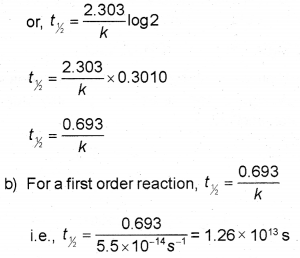
Question 24.
What are adsorption isotherms? Write the Freundlich adsorption isotherm equation and plot a graph based on it.
Answer:
Adsorption isotherms are curves used to express the variation of the amount of gas adsorbed by the adsorbent with pressure at constant temperature.
The Freundlich adsorption isotherm gives an empirical relationship between the quantity of gas adsorbed by unit mass of solid adsorbent and pressure at a particular temperature. The relationship can be expressed by the equation:
\(\frac{x}{m}=k \cdot P^{1 / n}\)
where x is the mass of the gas adsorbed on mass m of the adsorbent at pressure P, k and n are constants which depend on the nature of the adsorbent and the gas at a particular temperature.
The relationship can be represented in the form of a curve where mass of the gas adsorbed per gram of the adsorbent (x/m ) is plotted against pressure(P).

Question 25.
Describe the steps involved in the manufacture of sulphuric acid by contact process.
Answer:
The Contact process for the manufacture of sulphuric acid involves three steps:
Step 1: Burning of sulphur or sulphide ores in air to generate SO2.
S(s) + O2(g) → SO2(g)
Step 2: Conversion of SO2 to SO3 by the reaction with oxygen in the presence of V2O5 catalyst at a pressure of 2 bar and a temperature of 720 K.

Step 3: Absorption of SO3 in H2SO4 to give oleum (H2S2O7).
SO3 + H2SO4 → H2S2O7
Dilution of oleum with water gives H2SO4 of the desired concentration.
Question 26.
Differentiate ferrimagnetism from paramagnetism and predict the change that takes place to ferrimagnetic substances on heating.
Answer:
Paramagnetism: Magnetic property which arises due the presence of one or more unpaired electrons. Such substances are weakly attracted by the magnetic field. They are magnetised in a magnetic field in the same direction and lose their magnetism in the absence of magnetic field.
e.g. O2, Cu2+, Fe3+, Cr3+.
Ferrimagnetism: Magnetic property observed when the magnetic moments of the domains in the substance are aligned in parallel and anti-parallel directions in unequal numbers as shown:

They are weakly attracted by magnetic field as compared to ferromagnetic substances.
e.g. Fe3O4 (magnetite) and ferrites like MgFe2O4 and ZnFe2O4.
Ferrimagnetic substances on heating lose ferrimagnetism and become paramagnetic.
Question 27.
a) Draw the structure of dichromate ion.
b) How can dichromate ion be converted to chromate ion?
c) Write examples for the oxidising action of potassium dichromate in acidic medium.
Answer:
a)

b) When an aqueous solution of dichromate is treated with alkali (i.e., by increasing the pH of the medium) it changes to chromate.
Cr2O72- + 2OH– → 2CrO42- + H2O
c) Acidified potassium dichromate oxides iodides to iodine, sulphides to sulphur, tin(II) to tin(IV) and iron(II) to iron(III).

Question 28.
Explain the following
a) Hydraulic washing
b) Zone refining
c) Roasting of ores
Answer:
a) Hydraulic washing: This is a method used for the concentration of ores. It is based on the differences in gravities of the ore and the gangue particles. It is type of gravity separation. Here an upward stream of running water is used to wash the powdered ore. The lighter gangue particles are washed away and the heavier ores are left behind.
b) Zone refining: It is a method used for obtaining extra pure germanium, silicon, boron, gallium and indium. It is based on the principle that the impurities are more soluble in the melt than in the solid state of the metal. Here a circular mobile heater is fixed at one end of a rod of the impure metal.
The molten zone moves along with the heater which is moved forward, the pure metal crystallises out of the melt and the impurities pass on into the adjacent molten zone. This process is repeated several times and the heater is moved in the same direction. At one end, impurities get concentrated. This end is cut off.
c) Roasting of ores: Roasting is used for converting ore to its oxide. It is mainly applied to sulphide ores. Here the ore is heated in a regular supply of air in a furnace at a temperature below the melting point of the metal, e.g.
2ZnS + 3O2 → 2ZnO + 2SO2 OR
2PbS + 3O2 → 2PbO + 2SO2 OR
2CU2S + 3O2 → 2Cu2O + 2SO2
Question 29.
Describe the following reactions.
a) Aldol condensation
b) Etard reaction
c) Rosenmund reduction
Answer:
a) Aldol condensation: Aldehydes and ketones having at least one α – hydrogen atom undergo a reaction in the presence of dilute alkali as catalyst to form β – hydroxy aldehydes (aldol) or β – hydroxy ketones (ketol) respectively. The aldol and ketol on heating readily lose water to give α, β – unsaturated aldehydes or ketones respectively.
e.g. Ethanal on treating with dil NaOH gives 3-hydroxy butanal which on heating loses water to give but-2-enal.

b) Etard reaction: When toluene is treated with chromyl chloride (CrO2Cl2) in CS2 a chromium complex is formed which on hydrolysis gives benzaldehyde.

C) Rosenmund reduction: When an acyl chloride(acid chloride) is hydrogenated over catalyst, palladium on barium sulphate the corresponding aldehyde is formed.
e.g. Benzoyl chloride on hydrogenation over catalyst, palladium on barium sulphate gives
benzaldehyde.

Questions from 30 – 33 Carry 4 Score each. Answer any 3 questions. (3 × 4 = 12)
Question 30.
Write chemical equations for the conversion of phenol to acetylsalicylic acid (aspirin).
Answer:
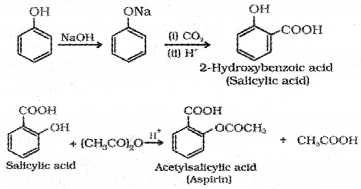
Question 31.
With the help of diagram describe the construction and working of a fuel cell using H2 and O2. What are the advantages of fuel cell over conventional cells.
Answer:
In the H2 – O2 fuel cell, hydrogen and oxygen are bubbled through porous carbon electrodes into concentrated aqueous NaOH solution. Catalysts like finely divided platinum or palladium metal are incorporated into the electrodes for increasing the rate of electrode reactions.
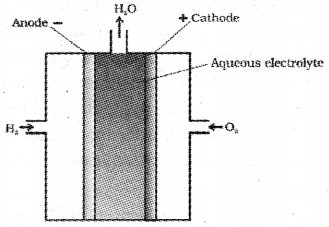
This cell uses the reaction of hydrogen with oxygen to form water. The electrode reactions are:
Anode reaction: 2H2(g) + 4OH–(aq) → 4H2O(l) + 4e–
Cathode reaction: O2(g) + 2H2O(l) + 4e– → 40H–(aq)
The overall reaction is, 2H2(g) + O2(g) → 2H2O(l)
Advantages:
- The cell runs continuously as long as the reactants are supplied.
- Fuel cells produce electricity with an efficiency of about 70%, which is much higher than that of conventional cells.
- Fuel cells are pollution free.
Question 32.
Sketch the Crystal field splitting of d-orbitals of the Central metal ion in [CoF6]3-. Also write the electronic configuration of central metal ion and predict its magnetic behaviour based on Crystal field theory.
Answer:
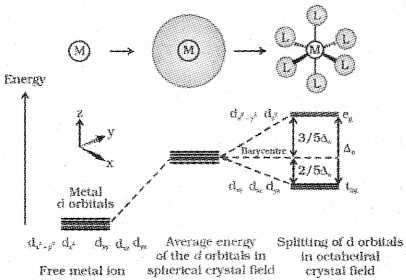
The electronic configuration of the central metal ion. Co3+ is [Ar]3d6 4s0.
Here F- is a weak field ligand. Therefore, Δ0 < P and no pairing occurs (\(t_{2 g}^{4} e_{g}^{2}\)). Thus, there are four unpaired electrons and hence [CoF6]3- is an outer orbital/high spin/spin free paramagnetic octahedral complex.
Question 33.
Give the structures and IUPAC names of the products formed on the following reactions.
a) Hydration of propene in the presence of dilute sulphuric acid.
b) Reaction of methanal with methyl magnesium bromide followed by hydrolysis.
Answer:
